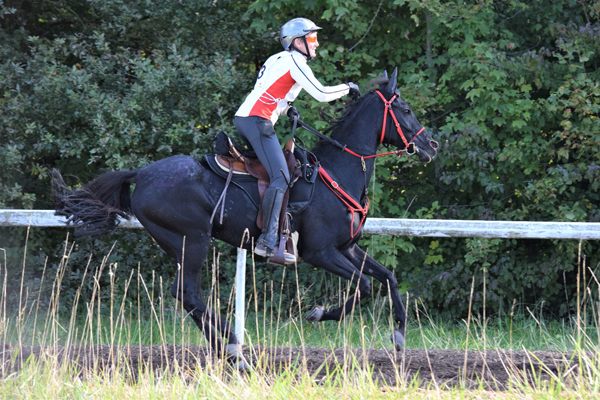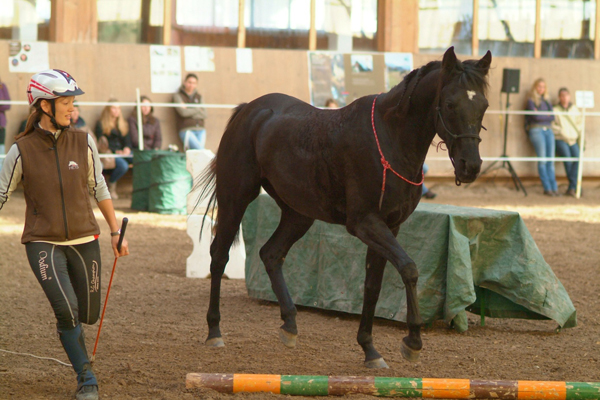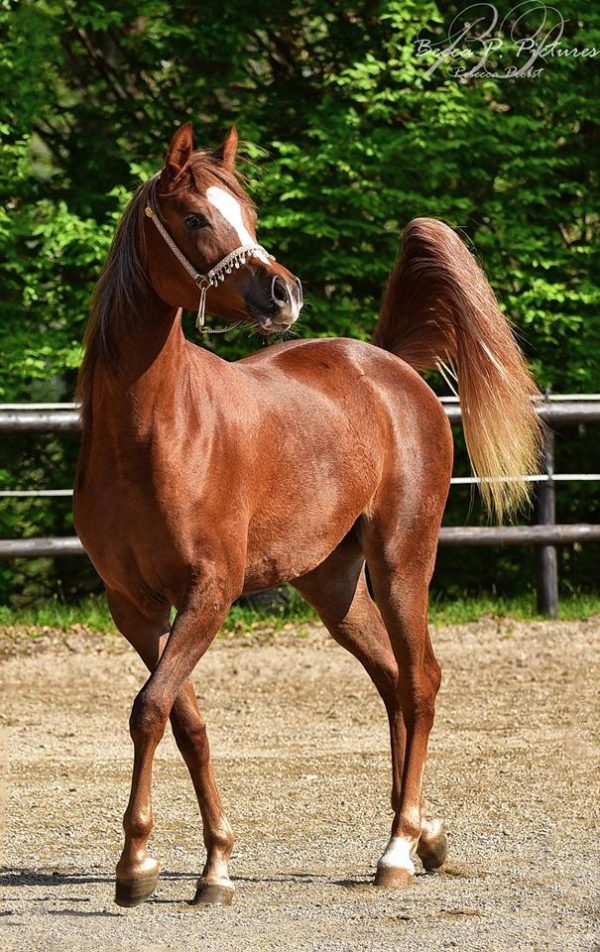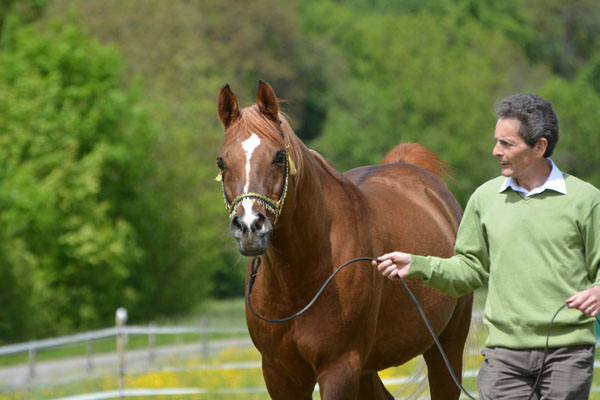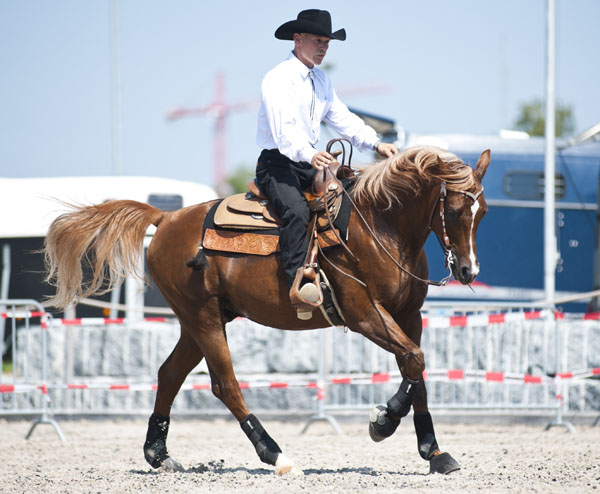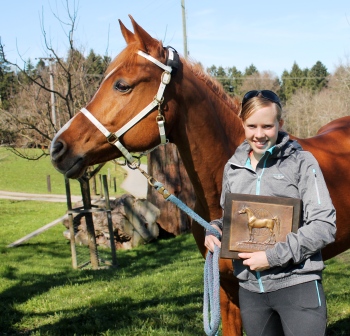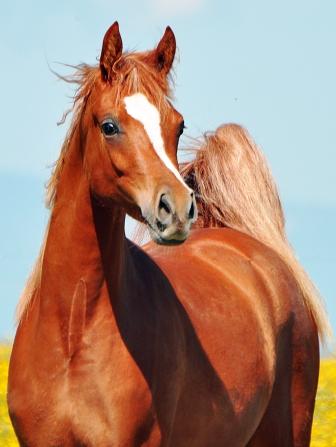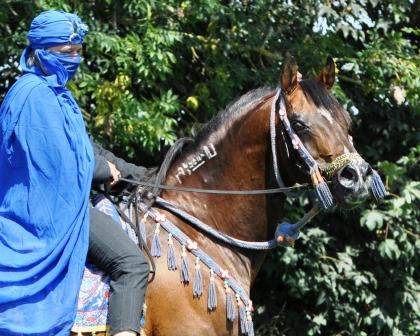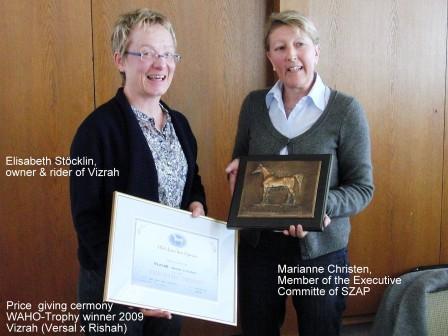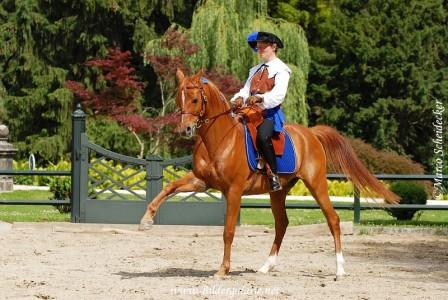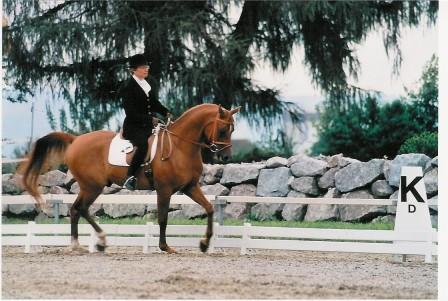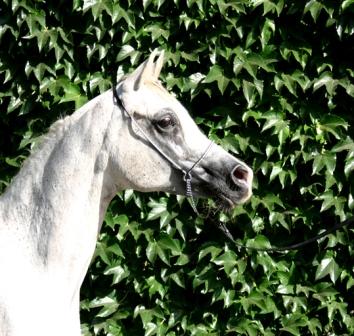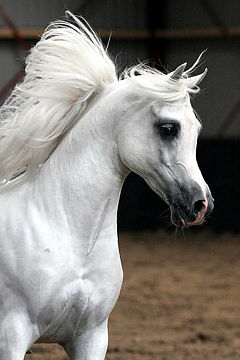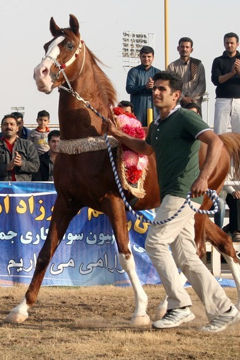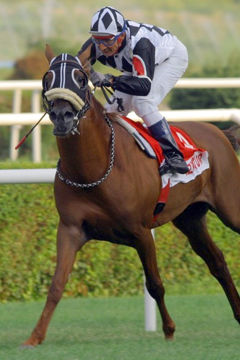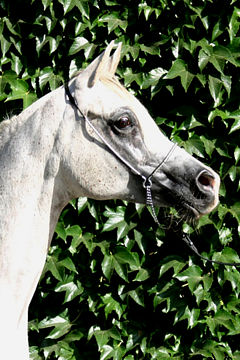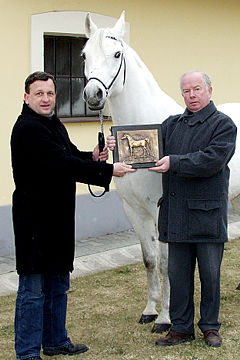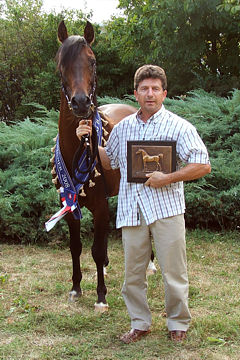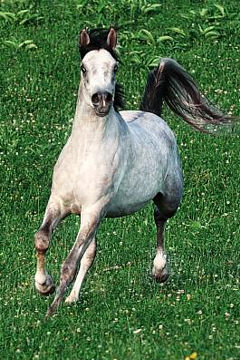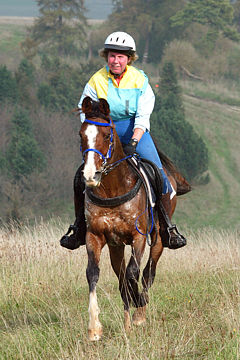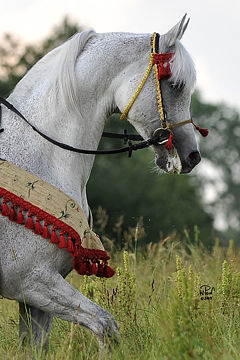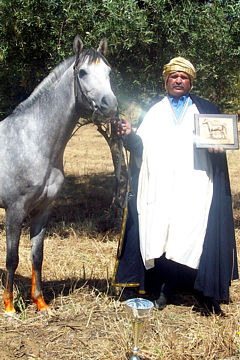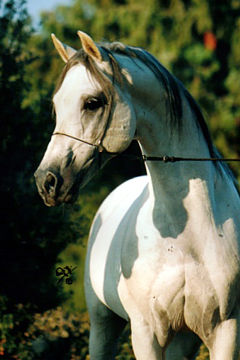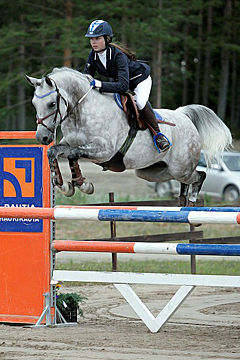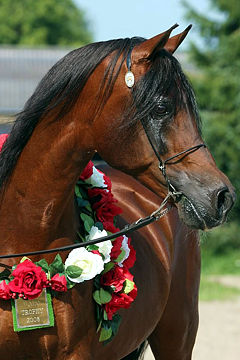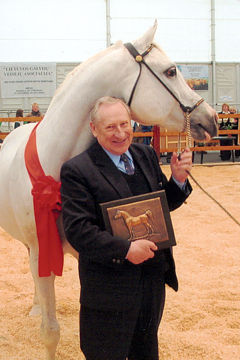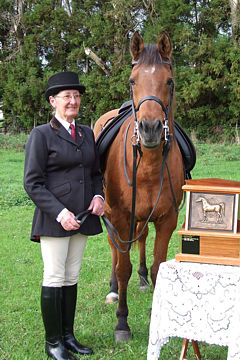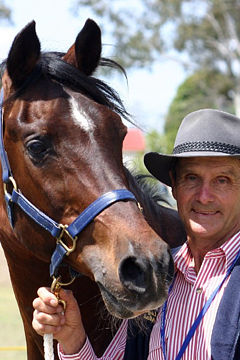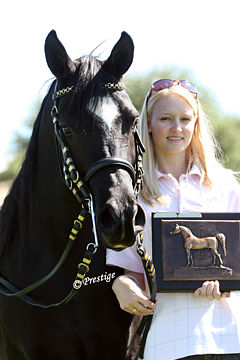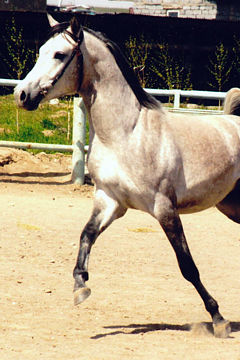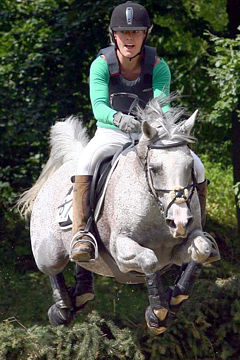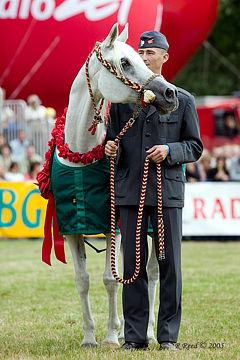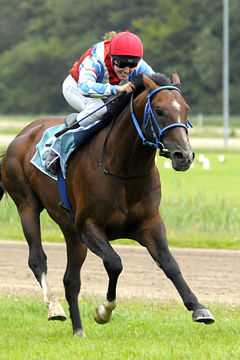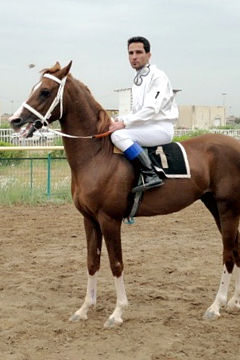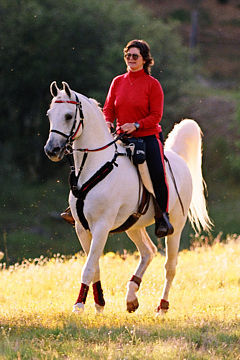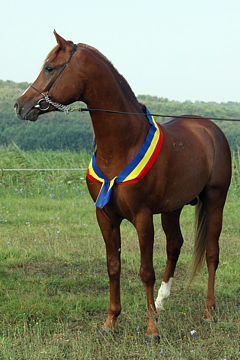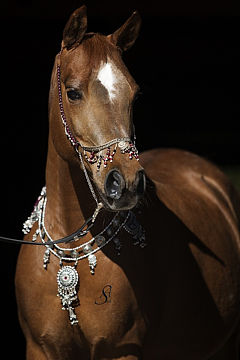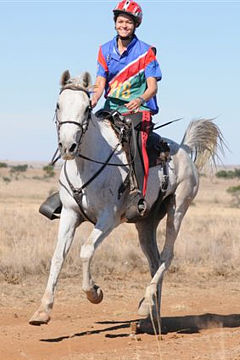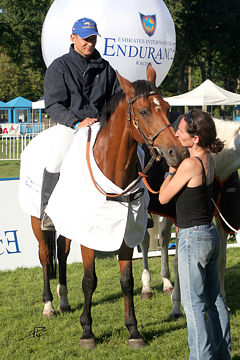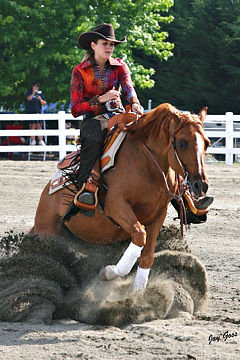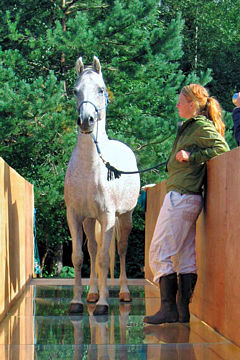![]()
Member Report from Switzerland
REPORT MADE AT THE 2022 WAHO CONFERENCE
Your Royal Highness, Mr. President, members of the Executive Committee, delegates, ladies and gentlemen. My name is Natalie Joerin, I am the studbook registrar of the Swiss Arab Horse Society / SZAP. In the name of the Swiss Breeding Society, I would like to express my heartfelt thanks to our hosts for their warm welcome and organising this conference in this beautiful country.
Since the last WAHO Conference, the SZAP registered about 20 foals a year but unfortunately this year, we had a break down to only 11 foals. We expect to recover to 20 foals again next year. Nevertheless, the numbers are crushing when thinking back to the 90’s where we had over 150 foals. There are about 2,500 Arabian horses living in Switzerland, many are purchased abroad in neighbouring countries and are unfortunately never reregistered in the Swiss Studbook. So currently we have 220 potential broodmares, 62 young stock and only 10 active breeding stallions registered.
Artificial insemination is growing in popularity and even if the Swiss Studbook allows one embryo transfer a year, this option has never been used. The Swiss stallions often only offer natural covering due to the high costs for producing fresh or frozen semen and the fact that Swiss Arabian stallions aren’t well known abroad.
The Arabian is well liked as a family horse in all sorts of disciplines and also is very popular for endurance riding. Covid 19 gave a blow to a lot of events in the past 3 years. This year the shows have picked up again and we hope to continue to promote the Arabian horse at different fayres and national events again.
We have a private group promoting dressage riding with Arabian horses. They have organised in the past two years 4 events a year and the popularity is continuously growing. After 2 years without a National Show in 2019 and 2020, that is held in a form of a “Breeding Show”, we had one in 2021 and this year. To encourage the few breeders to show their young and breeding stock at the National Show, we have included the entry fee for our shows in the fee of the registration papers. This is not only to encourage the owners and breeders to show their horses, but our Agricultural Department wants us to collect data of the Arabian Horses in Switzerland. We hope to see more young horses in future.
We announce every year a WAHO Trophy winner and hand over the prize at our AGM. The Trophy winner in 2020 was a lovely 19-year-old bay mare Ahira Bint Narym (Narym x Asari Bint Grand). She is a wonderful ambassador for the dressage ridden Arabian. The 2021 WAHO Trophy went to the gorgeous 4-year-old Bo.A.S. Emeraya (Emerald J x Bo.A.S. Naganya). She is a great representative of Swiss Breeding at International Shows.
The last published Studbook was Volume 11 covering the period 2013 to 2019, published in 2020. Since 2021 we have had a very informative online Studbook created by Bruno Furrer, who is also involved with Shagya horses. The online Studbook is open to everybody and we invite all people interested to take a look. There is a lot of information found on the horses including sire line and dam line of the horse, place of birth, any known achievements and more.
REPORT MADE AT THE 2019 WAHO CONFERENCE:
Didier Thievent, Switzerland: Mr President, Members of the Executive Committee, Delegates, ladies and gentlemen. My name is Didier Thiévent, I am a past Registrar and the Delegate of the Swiss Arab Horse Society for this Conference.
The Swiss Breeding Society for Arabian Horses has experienced two very difficult years. The new elected President Renata Schibler found in 2017 a Society with serious financial problems and a rapidly declining membership. 2017 ended with an internal power struggle that resulted in the deselection of the board members. At the AGM in 2018, a new committee was elected, and Renata Schibler was confirmed as President. Fortunately, the strong decline of members could be stopped, and the committee is working hard to get people to join the Society again. They organize courses for Arabian horse owners and encourage potential breeders to pick up their breeding programmes again.
Like other countries, Switzerland has experienced a strong decline of Arabian foal births in the past 10 years. At present, there are over 2,500 living Arabian horses registered. The number of Arabian foals born in the past 3 years has settled at around 20 to 30 foals per year. Compared to 10 years ago, that is a decline of 60%. There are different reasons for this stagnation at a very low level that have been outlined on previous Conferences. 10 or 20 years ago there were a handful of breeders with a fair amount of foals each year. These breeders have either moved their studs abroad or have stopped their breeding programmes due to age and lacking successors. The current Swiss breeders each have one to three foals a year, but not on a regular basis. They further often report that it can be very difficult to sell offspring.
In Switzerland the Arabian horse is very popular for endurance and for people without great sport ambitions but who want to do a lot of different activities on a novice level. These people cherish the versatility of the Arabian horse. There were 9 endurance events in 2018, organized by an independent Federation. In 2017 the National show had to be cancelled due to insufficient entries, only dressage, western and gymkhana classes were held. Last year, the Society organized a small show for breeders, as well as dressage competitions and a gymkhana contest. There is a group of Swiss western Arabian riders that promote and support western Arabian horses. There is a very small number of Arabians that do showing, racing, show-jumping, driving, but their numbers are marginal compared to endurance. We also have a yearly ranking for registered Arabians in these sport categories and the best horses under saddle and at shows are honoured with rosettes and prizes. This is to motivate our breeders and owners to show their Arabians under saddle and illustrate their achievements to the group of Arabian horse people.
Ten years ago, a voluntary stallion categorization was introduced that serves as an information and guidance tool to help our breeders compare the stallions. The stallions are judged on the criteria of conformation and movement, health, performance under saddle and the quality of the offspring. The stallions are categorized in each criteria with A for outstanding, B for good and C for limited performance. Nearly all active Swiss breeding stallions have participated and have been categorized at least in one of the above-mentioned criteria.
The SZAP announces every year a WAHO Trophy winner and hands over the prize at the AGM. The Trophy winner in 2017 was the 20 year old bay mare Sha Mara, an exceptionally versatile and successful Arabian mare in dressage as well as western riding classes. In 2017 she won the Swiss National Championship title in showmanship at halter. The WAHO Trophy winner 2018 is the chestnut champion filly and best in show winner ,“H” Goghleine by Van Gogh AM out of Galila, bred and owned by Emanuela Lucini.
In 2019 we are planning different seminars on veterinary aspects of breeding, on show training, and riding as well as our annual event with show and riding classes. Our current published stud book covers the years 2009 to 2012. The next volume covering the years 2013 to 2016 is in preparation and will be published in .pdf format this year. In the long term the SZAP would like to publish an online pedigree database. Thank you very much for your attention.
REPORT AT 2017 WAHO CONFERENCE:
Hans-Juergen Gottet, Switzerland: Your Royal Highness, Excellencies, Chairman of WAHO, Executive Committee of WAHO, all Delegates, ladies and gentlemen. Switzerland would like to thank the Kingdom of Bahrain and all of the persons in charge of organisation for this unique WAHO Conference.
My name is Hans-Juergen Gottet, I am a member of the Executive Committee of the Swiss Arab Horse Society and I would like to present to you the report of our Society for the WAHO Conference General Assembly in Manama, Bahrain.
At present there are about 2,580 living Arabian horses registered in the Swiss Stud Book. Since 2014, the number of foals has decreased by 30%, a similar decline has been observed with all other horse breeds in Switzerland. The demand for horses seems to have subsided, partly for economic reasons. Over the last three years the number of imported horses has increased ,mainly due to the reduced fees for the import registration.
Our Society organises one show with halter classes, and a yearly sports event. At the sports event there are classes in English dressage, Western riding and horse agility. Some of our Arabians compete successfully against warmbloods in dressage. The number of races has increased over the last three years. This year 3 races have taken place on the frozen lake of the famous town of St. Moritz. Endurance is a popular sport in Switzerland, every year there are several rides, ranging from 30 kilometres up to 120 kilometres run by the Swiss Endurance Society. We are trying to promote the Arabian horse in the media and at all-breed horse events.
The WAHO trophy is awarded at the General Assembly of the Society and the winner is presented in the Society’s own magazine and on the website. The Society publishes information about the breed in our magazine and on our website. Furthermore we organised a seminar in breeding. We have every foal tested for SCID and CA, unless both parents are proved as non-carriers. Our current published stud book covers the years 2009 to 2012. The next volume covering the years 2013 to 2016 is just now in preparation and will be published in PDF format in the year 2018. Thank you very much for your attention.
REPORT AT 2014 WAHO CONFERENCE:
Hans-Juergen Gottet, Switzerland: My name is Hans-Juergen Gottet from Switzerland. Mr. President, members of the Executive Committee, fellow delegates and guests, ladies and gentlemen. I am glad to report to you on behalf of the Swiss Arab Horse Society, but before I start I would like to thank our hosts the Qatar Racing & Equestrian Club for their perfect organization of this great conference and for their hospitality and generosity.
At present there are about 2,550 living horses registered in the Swiss studbook. Since 2011, the number of foals has decreased by 29%. A similar decline has been observed with all horse breeds in Switzerland. The demand for horses seems to have subsided, partly for economic reasons. The number of imports and exports of Arabian horses did not change over the last three years.
Our Society organizes one show with halter classes and a riding class, and a yearly sports event. At the sports event there are classes in English dressage, western riding, and horse agility. The number of races has increased over the last three years, and a famous yearly race on a frozen lake in St. Moritz has been established. Endurance is a popular sport in Switzerland. Every year there are several rides ranging from 30 km up to 120 km run by the Swiss Endurance Society. The percentage of Arabians taking part in official competitions of all kinds is estimated at about 5%.
We are trying to promote the Arabian horse in the media and at all-breed horse events. This year we presented registered Arabian horses used in dressage, driving, western riding, endurance, and horse agility to the general public in a big show. The WAHO Trophy is awarded at the General Assembly of the Society, and the winner is presented in our own magazine. It is difficult to know whether this award is attracting new people into our Society. The Society publishes information about the breed in our own magazine, and on our website. The results of halter and sports classes are also presented in the most popular weekly horse magazine of Switzerland. Furthermore, we are planning seminars on breeding, and training courses, in the next year.
We have every foal tested for SCID and CA. The Society has decided to make these tests compulsory. The import of horses to Switzerland is subject to a quota of 3,822 horses, all kinds of horses, per year. The owner has to pay a fee of 3,834.00 Swiss Francs to the government for every horse imported if the quota is exceeded.
Our current public studbook comprises the years 2004 to 2008. The next volume is in preparation, and will be published in pdf format approximately at the end of 2014. I would like to thank you for your attention.
REPORT AT 2011 WAHO CONFERENCE:
Mr. Didier Thiévent, Switzerland: Mr President, members of the Executive Committee, delegates, ladies and gentlemen. My name is Didier Thiévent, I am the Registrar and the Delegate of the Swiss Arab Horse Society for this Conference.
Our Society has about 450 members, we have a computerized Database for registered Arabians and we actually have about 2,500 living registered purebred Arabians in our country. The number of our foal registrations, imports and exports in 2010 are more or less the same as over the last 3 years.
The principal official activities for purebred Arabians in Switzerland are endurance riding, dressage, show jumping and cross-country, western riding, racing, driving and showing. These activities are mostly run by an independent body or federation, but our Society organises an annual one-day sport event and in 2011 we had 120 entries. We also have a yearly ranking for registered Arabians in these categories and the best horses under saddle and at shows are honoured with rosettes and prize money. This is to motivate our breeders and owners to show their Arabians under saddle in public. The percentage of registered Arabians in our country which take part in these different activities is about 5-6%. But the overall percentage of ridden purebred Arabians between 3 and 20 years old is at approximately 80-90%. Since 2006 we have developed an Elite Broodmare and Stallion scheme, not only to acknowledge and honour Arabian mares and stallions of particular significance but also to provide as much information as possible for the breeders and to help them with their breeding decisions. Since 2007 we have a stallion categorization on a voluntary basis. The categorization of the breeding stallions serves as an information instrument, which gives our breeders transparent and comparable information. The stallions are judged on the criteria of conformation and movement, health, performance under saddle and the quality of the offspring. The stallions are categorized in each criteria with A for outstanding, B for good and C for limited performance. Till today 65% of the active breeding stallions have participated.
Testing on genetic disorders: In 2001 our members decided democratically to test all breeding horses on SCID as a mandatory rule. We have no restrictions on SCID carriers but all foals are SCID-typed if both parents are not tested SCID-clear. Since we began to test on SCID this genetic disorder has been eliminated in our population by more than 99%. At the Annual General Meeting in 2010 our members decided that all breeding stallions have to be tested for Cerebellar Abiotrophy beginning 1st January 2011. All new born foals are tested since the foal season 2010. All broodmares are highly recommended to be tested before breeding. We have no restrictions on CA carriers but our policy is “Test before you breed”. This system of CA-testing is highly supported by our members and after one year approximately 50% of the active broodmares have been tested voluntarily. Out of about 300 tests we found 18% carriers and 1% affected horses.
We have a performance test in endurance, flat racing, dressage, jumping and western disciplines, but only a few horses took part. Our society participates at a few national horse events with a stand and brings horses to be shown either at halter or under saddle. The effects of these public relations are not clearly noticeable but we keep on. Our yearly ranking in sport events motivates our members to show their Arabians under saddle in public and supports the marketing of our horses. Since the WAHO Trophy was created, it has mostly been awarded to all-round sport horses but to some exceptional breeding horses too. This award is much appreciated by our existing members but it seems, unfortunately, not to bring new people into the breed. We bring various informations about breeding, riding and welfare to our members in our own magazine and our website. The general public is informed from time to time about the use of the purebred Arabian horse and their success in the biggest weekly general horse publication in Switzerland. Our current stud book is volume 9 covering the years 2004 to 2008. The PDF-file is available on the website of our Society. The next stud book is planned for 2013 as a PDF-document too but, with a little luck, we will have an online pedigree database a little earlier.
Last but not least I would like to express my thanks to our hosts and all the organizing people for their excellent work and great hospitality. Thank you very much for your attention.
REPORT MADE AT 2009 WAHO CONFERENCE:
My name is Didier Thiévent, I am the Registrar and the Delegate of the Swiss Arab Horse Society for this Conference. And this is our report.
Our Society has about 500 members, we have a computerized Database for registered Arabians and we actually have 2,504 living horses registered in our country. Volume 9 of our stud books is in preparation, covering the years 2004 to 2007. I hope it will be published towards the end of the summer. Approximately 200 mares and 30 stallions are used for breeding.
We registered 70 foals in 2007 and 77 foals in 2008. The foal registrations dropped by 45% during the past 15 years, comparing to the year 1992 when the maximum number of foals we ever registered in our Society totalled 135. This reflects the difficult market situation in Switzerland, especially in the last 10 years resulting from the upcoming breeds of western horses and other special breeds for recreational use. Certainly also the way that the halter show scene seems to be becoming even more and more crazy may be having a greater negative impact in putting people off breeding Arabians in our country. But the Swiss Arab Horse Society is actually reinforcing her efforts to promote the ridden Arab horse in the market.
We have been using DNA-typing since 1993 for all breeding horses and the foals are parent verified at registration. Since 2001 we ask for all breeding horses to be SCID tested. We have no restrictions on SCID carriers but all foals are SCID-tested unless both parents are already tested SCID-clear. Till today our foals are not microchipped at registration. A new federal law will probably force us to do this in the near future. As we have a small Purebred Arab horse population, we only had 16 imports in 2007, and 10 exports, most of them from and to European countries.
Our mares are mostly covered by natural service, but Artificial Insemination via fresh, chilled, or frozen semen, both domestic and imported, is allowed. We allow post-mortem use of frozen semen with no time limit. We allow the export of semen. Embryo Transfer is permitted only if the receiving mare is a purebred Arabian and must be granted by the Executive Committee of the Society. In the year 2008 only one stud was interested in Embryo Transfer but no foal was actually produced by Embryo Transfer. Till today multiple foal registration by Embryo Transfer is permitted, but will probably change at this year’s general meeting and in the future only one foal per calendar year will be registered.
We issue a Registration Certificate and since 1996 also a Passport. Our passport is recognized by the F.E.I, but must be confirmed by the Swiss Equestrian Federation before. Until today we do not issue UELN numbers.
Since 2006 we developed an Elite Broodmare and Stallion scheme, not only to acknowledge and honour Arabian mares and stallions of particular significance but also to provide as much information as possible for the breeders and to help them with their breeding decisions. Since 2007 we have a stallion categorization on a voluntary basis. The categorization of the breeding stallions serves as an information instrument, which gives our breeders transparent and comparable information to help them with their breeding decisions. The stallions are judged for the criteria, conformation and movement, health, performance under saddle and the quality of the offspring. The stallions are categorized in each criteria with A, B or C, A stands for outstanding, B for good and C for insufficient. Until today 30 stallions have participated.
For 16 years now our society has organized an annual National Stock Show for Purebred Arabian horses. At this show we try to judge the horses in a more detailed and breeding oriented way than at the ‘normal shows’. The horses are not only shown at hand but also free and we use 11 criteria. The judges make comments on the evaluation sheet for the different criteria with particularly high or low scores. So the owner of the horse has much better information about the qualities of his horse. Also, every 3 or 4 years we also organize a National Championship under ECAHO rules.
Arabian races are held normally 4 times a year and there are 12 Endurance Events per year with about 30 registered purebred Arabians participating at medium and high level. The Swiss Team finished in third and fourth place in the Junior European Championships in 2007 and 2008. We have had a performance test in endurance and in flat racing for many years, but unfortunately only a few horses have taken part so far. The principal activities for purebred Arabians in Switzerland are breeding, endurance riding, dressage, show jumping and cross-country, western riding, racing, driving, showing and of course, pleasure riding. We also have a yearly ranking for registered Arabians in these categories and the best horses under saddle are honoured with rosettes and prize money. This is to motivate our breeders and owners to show their Arabians under saddle in public. At a few national horse events we participate with a trade-stand and bring horses to be shown either at halter or under saddle. The effects of these public relations are not yet clearly noticeable but we keep on trying.
Since our society promotes an all-round Arabian horse, the WAHO Trophy has been awarded in 2006 to the 20 year old stallion Jeridan out of Egyptian and English bloodlines, and in 2007 to the also 20 year old Amal Ibn El Sharai out of Spanish, Egyptian and English bloodlines, both for their exceptional achievements in dressage, show jumping and cross-country. In 2008 the WAHO Trophy was given to the 2 year old filly Eysha El Azrak out of Polish and Egyptian bloodlines based on her exceptional results in shows. All in all we can state that, despite the actually lower number of registered foals per year, we have a stable population of Purebred Arabians in Switzerland. The enthusiasm for the beauty and the gentle nature of the Arab horse is still large and the society will do all it can to promote our breed to the public. For that reason also the WAHO Trophy is very highly esteemed. Thank you to all the people who made this award possible.
PREVIOUS REPORTS:
The Current stud book is Volume 8, covering the period 2000-2003. The Swiss Arab Society has about 550 members and there are approximately 2000 horses registered. There are generally an average of 100 breeding mares and 30 breeding stallions. In 2006, the number of foals registered was 87. In 2006 there were 11 exports and 10 imports. We have used DNA for a number of years, and since 1993 we have required parent verification, previously by blood-types. Artificial Insemination is allowed, also transported semen. We only allow Embryo Transfer with special permission. We have issued and used passports since 1996. Artificial insemination and transported semen are allowed, also embryo transfer.
There are several ridden programmes supported by the Society, there is a dressage trophy, a western trophy and a long distance trophy. Riding in Switzerland is a bigger market than showing. There is one Arabian show per year, there are also 5 race meetings and 10 endurance rides.
In 2007, Switzerland registered 66 foals, and recorded 10 exports and 7 imports.

